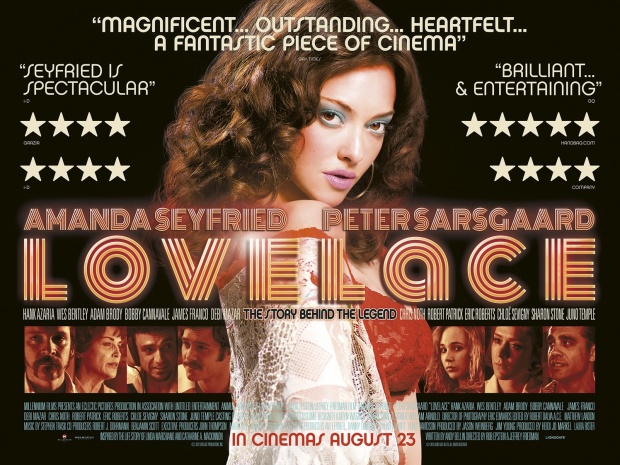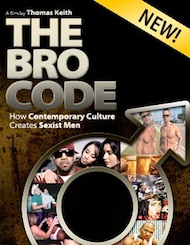 |
| Amanda Seyfried as “Linda Lovelace” |
This is a guest post by Gabriella Apicella.
When was the last time you cried in a movie theatre? The last time you were so moved by a film you needed everyone else to leave before ungluing yourself from the seat and attempting to process what you’ve experienced? Or the last time you saw something that made you feel that if enough people saw it, the world could be changed for the better?
None of these things happen to me too often, but this evening while watching Lovelace, I experienced all three.
I’ve been following the release of this film with some interest. As a dedicated feminist with a fiercely anti-porn stance, I was certainly not expecting anything particularly groundbreaking when I saw the movie posters plastered on the walls of my local underground station. Showing an objectified Amanda Seyfried in a lacy bra with wide eyes and an innocent pout, I very quickly assumed this would be a film for me to try and forget existed (much like the endless Fast and Furious rehashes). And then I heard that Gloria Steinem and Catherine Mackinnon were involved. For those who hadn’t heard, they were both consultants on the film, in their roles as caretakers of Linda Boreman Marchiano’s estate.
 |
| Linda Boreman Marchiano (aka Linda Lovelace) |
(This excellent article by Catherine Mackinnon explains a bit more about their involvement and is well worth reading.)
Dreadful acts of abuse feature all too regularly on our screens. Even on television it has become increasingly common to see ever more graphic gore and sadistic violence. As Lovelace has an 18 certificate (equivalent to R in the US) and being superficially familiar with the story beforehand, I had braced myself for a barrage of scarring images, expertly shot and edited and due to reappear in my nightmares for weeks to come. This is one of the quandaries that I have wondered about as a screenwriter – how to depict scenes of distressing acts without compromising your viewer, or making them complicit with the abuse, or, in fact, abusing them as well. However, it may be that by their sensitive and elegant handling, the filmmakers of Lovelace have actually revolutionised an area of storytelling that has prevented some of the most shocking and distressing yet crucially important films from either being made or from being seen.
The film intelligently portrays a great deal of what Linda Boreman Marchiano experienced and yet does not subject the audience to the horror. Not only does this make it a safer viewing experience, it also puts the audience’s emotional identification with the protagonist first. Linda remains a whole character throughout rather than becoming a body upon which hideous acts are carried out. We do not shift into passive voyeur or spectator, as traumatising scenes in The Accused, Monster, Straw Dogs, Irreversible, or any number of other films depicting domestic and sexual violence force the audience to do.
 |
| Adam Brody and Amanda Seyfried in Lovelace |
One of the defending arguments the Director Michael Winterbottom employed when graphically depicting the violent beating of both female characters in his film, The Killer Inside Me was that:
“It was intentionally shocking. The whole point of the story is, here is someone who is supposed to be in love with two women who he beats to death, and of course the violence should be shocking. If you make a film where the violence is entertaining, I think that’s very questionable.”
What Lovelace opens up is the possibility that it is not actually necessary to show violence – shocking, entertaining or otherwise, in order to interrogate these issues on film.
For people affected by domestic or sexual abuse and violence, either personally or otherwise, films about these subjects are of huge interest. The matters are of enormous concern, and knowing the power of the media, it is only natural that these same people would wish to watch any major productions tackling these issues. And yet, viewing violence onscreen has the potential to trigger traumatic responses, so this same audience frequently stays away from this material and is thereby excluded from the conversations (as if they need to be silenced any more than they are already!)
 |
| Amanda Seyfriend as Linda Boreman Marchiano in Lovelace |
As I attempt to process the devastating story of Linda Boreman Marchiano, only a fraction of which is actually covered in the film Lovelace (her activism and later years are not depicted), I am struck by the excellent performances, my enduring loathing for uber-pimp Hugh Hefner, and the exceptional influence of two feminist icons on the making of this important film.
What kept me sobbing in my seat throughout the credits and for some time in the lobby after the film, however, was the knowledge that this is not a one-off case, nor was it the worst case scenario. Porn has grown in both financial terms and in the levels of violence and degradation performers endure. What Linda experienced was horrifying. It continues, on an industrialised scale, and yet we are so very far from ensuring the safety of those who are exploited by it. Linda Boreman Marchiano’s mission was to raise awareness around domestic violence and the realities of the porn industry so that people who are being abused can reach safety. As part of realising her legacy, I urge you to watch this film and take a skeptical friend: they may just start to think differently after seeing it …
Gabriella Apicella is a feminist writer and tutor living in London, England. She has a degree in Film and Media from Birkbeck College, University of London, is on the board of Script Development organisation Euroscript, and in 2010 co-founded the UnderWire Festival that aims to recognise the raw filmmaking talent of women. Her writing features women in the central roles, and she has been commissioned to write short films, experimental theatre and prose for independent directors and artists.


